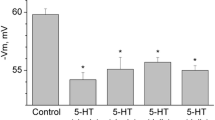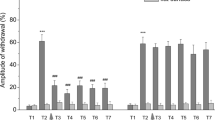Abstract
Combined presentation of food and noxious electrical stimulation produced no response in snails injected 6–16 days previously with 5,7-dihydrooxytryptamine, which produces degeneration of serotoninergic nerve terminals and reduced serotonin synthesis, although a defense (aversive) response was observed in the control group. Application of serotonin to a preparation of the snail central nervous system (contained in a bath) was used as reinforcement during neurophysiological experiments. The amplitude of synaptic response to nerve stimulation increased significantly in preparations in which stimulation was paired with serotonin application. After 3–7 sets of twin stimuli consisting of serotonin application and applying a drop of juice to the chemoreceptive surface area of the skin, a spike response to the latter stimulus was produced. No such effects were seen in response to unpaired stimuli. It was deduced that serotonin makes a major contribution to establishing conditioned aversive reactions in the snail.
Similar content being viewed by others
Literature cited
É. A. Asratyan, Physiology of Conditioned Reflexes [in Russian], Nauka, Moscow (1970).
P. M. Balaban, I. S. Zakharov, and V. N. Mats, "Selectivein vivo staining of serotoninergic nerve cells with 5,7-dihydroxytryptamine," Dokl. Akad. Nauk, SSSR,283, No. 3, 735–737 (1985).
B. I. Kotlyar, Mechanisms of Establishing a Temporal Connection [in Russian], Izd. Moscow Univ., Moscow (1977).
O. A. Maximova and P. M. Balban, Neuronal Mechanisms of Behavioral Plasticity [in Russian], Nauka, Moscow (1983).
H. G. Baumgarten, S. Jenner, A. Björklund, et al., "Serotonin neurotoxins," in: Biology of Serotonergic Transmission, N. N. Osborne, editor, Wiley and Sons, London (1982), pp. 249–277.
T. H. Carew, R. D. Hawkins, and E. R. Kandel, "Differential classical conditioning of a defensive withdrawal reflex inAplysia californica," Science,219, No. 4583, 397–400 (1983).
R. D. Hawkins, T. W. Abrams, T. J. Crow, and E. R. Kandel, "A cellular mechanism of classical conditioning inAplysia: activity-dependent amplification of presynaptic facilitation," Science,219, No. 4583, 400–405 (1983).
L. Hiripi, J. Nemcsok, and J. Salanki, "The effect of 5,6-dihydroxytryptamine on the serotonergic system of the musselAnodonta cygnea L." Comp. Biochem. Physiol., Ser. C,69, No. 2, 407–410 (1981).
E. R. Kandel and J. H. Schwartz, "Molecular biology of learning: modulation of transmitter release," Science,218, No. 4571, 433–443 (1982).
M. Klein, J. Camardo, and E. R. Kandel, "Serotonin modulates a specific potassium current in the sensory neurons that show presynaptic facilitation," Proc. Natl. Acad. Sci., USA,79, No. 10, 5713–5717 (1982).
I. Kupfermann and K. R. Weiss, "The command neuron concept," Behav. Brain Sci.,1, No. 1, 3–10 (1978).
V. W. Petreath, M. S. Berry, and N. N. Osborne, "The serotonergic cerebral cells in gastropods," in: Biology of Serotonergic Transmission, N. N. Osborne, editor, Wiley and Sons, London (1982), pp. 457–513.
S. O. Ögren, "Central serotonin neurons and learning in the rats," in: Biology of Serotonergic Transmission, N. N. Osborne, editor, Wiley and Sons, London (1982), pp. 317–334.
S. O. Ögren, G. Johansson, and T. Archer, "Serotonin neurons and aversive conditioning in the rat," Scand. J. Physiol., Suppl.1, 7–15 (1982).
Additional information
Institute of Higher Nervous Activity and Neurophysiology, Academy of Sciences of the USSR, Moscow. Translated from Neirofiziologiya, Vol. 18, No. 3, pp. 291–298, May–June, 1986.
Rights and permissions
About this article
Cite this article
Balaban, P.M., Zakharov, I.S., Maximova, O.A. et al. Contribution of serotonin to establishing a conditioned food aversion reflex in the snail. Neurophysiology 18, 209–214 (1986). https://doi.org/10.1007/BF01052537
Received:
Issue Date:
DOI: https://doi.org/10.1007/BF01052537




